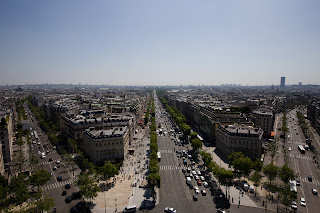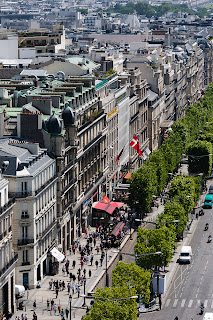This monument, begun in 1806 in honour of the Grande Army,
interrupted for a longtime and then continued with new dedication in 1823,
interrupted for a longtime and then continued with new dedication in 1823,
was completed in 1836 by King Louis Philippe I, who consecrated it to the glory of the French Armies.
The monument is 50 metres high, and the largest vault is 29 metres high (just under 100 feet)--large enough for Charles Godefroy to fly his plane through when celebrating the end of WW I.
Inscriptions covering much of the outside recall each of the battles and generals of the Napoleonic wars, and there is a tomb to an unknown French soldier killed in WW I.
There is no elevator, but winding stairs let us climb the 160 feet and get some glorious views of the city.
Once you are nearly at the top, there is a large room with a number of displays, including the inscription with which this entry began, photographs and a model of the monument as designed by Jean Chalgrin in 1806.
Visitors going to the open top of the Arc de Triomphe have excellent views through a tastefully designed protective fence (which is photographed repeatedly daily).
From the top, one can step up onto an outer walkway which goes around the entire structure. These photos show just a few of the city's monuments as seen from this vantage point. Haussmann did indeed redraw much of Paris so that major roads radiated in all directions from this hub, like so many spokes on a wheel. The resulting gigantic roundabout could create some "interesting" traffic patterns, but everything is orderly.
We are now looking east, along the famous Champs-Élysée which leads to the Louvre, formerly a palace and now a grand museum.
The following view shows Sacré-Coeur on the distant hill.
A telephoto lens brings into view the ancient Egyptian obelisk from the temple for Ramses II at Thebes. This obelisk, more than 3,200 years old, now stands in the centre of the Place de la Concorde (Peace) about halfway between the Arc de Triomphe and the Louvre. Behind "Cleopatra's needle" (the obelisk) is the sprawling Louvre, now housing both a museum and government offices.
In the following photo, we can catch a glimpse of the Notre Dame Cathedral with its two square towers and 19th-c spire, and in the foreground, the beautiful Grand Palais des Champs Élysée, built for the Expo in 1900. This was the last such structure of glass to be built in imitation of London's Crystal Palace. Just beyond the Grand Palais you can see the low-lying Musée D'Orsay with its curved roof, formerly a railroad station, now my favourite museum in Paris.
The following photo shows the Baslilque de Sacre-Coeur (Church of the Sacred Heart) on the hill in the upper left corner, and the mid-19th century Église Saint-Augustin de Paris (Church of St Augustine).
Again, Sacre Coeur, seen over thousands of roof tops and chimneys.
Looking down, people are heading to their favourite cafés and restaurants, some with sidewalk tables under awnings. The trees of the Champs Élysée have been carefully squared for the summer. You will also appreciate the regulation that no new building in Paris can be more than about 6 floors high. This gives a uniformity to the city, and lets the principal monuments appear more grand than if they were surrounded by modern skyscrapers, as is the case for poor St Patrick's Cathedral in New York City.
Finally, we look away from Paris proper, toward the west, where La Défense can be seen in the distance, and the Bois de Boulogne (Boulogne Woods) stretching from the left toward the centre of the photo.


















